
Features
Aggregates
Profiles
Tried and True Meets New
This quarry just north of Toronto has integrated its existing equipment with some new gear
December 13, 2011 By Bill Tice
Upon arrival at the Walker Aggregates Severn Pines Quarry just North of
Orillia, Ont., it doesn’t take long to realize there is something
different about this operation
Upon arrival at the Walker Aggregates Severn Pines Quarry just North of Orillia, Ont., it doesn’t take long to realize there is something different about this operation. Your first clue is the 70-ton CAT haul truck heading your way. It’s not your traditional yellow and black Caterpillar colours. Instead, it has been repainted in bright yellow and blue tones, representing the corporate colours of parent company Walker Industries.
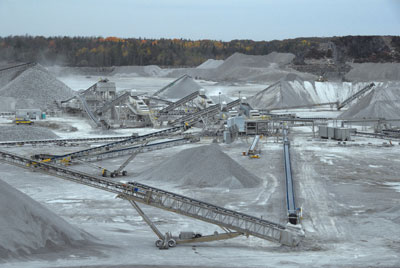 |
|
| The latest upgrade at the Severn Pines quarry resulted in the operation almost doubling its production volumes.
|
“It’s all about company pride,” explains Severn Pines superintendent Roger McGillvray when talking about the paint job on the haul truck. “All of our equipment at all of our operations, whether it is on- or off-road, is identified with our corporate colours.”
But the paint job is just the start. McGillvray says that same pride flows through to the production process where company employees “go the extra mile,” and he adds it is evident in day-to-day operational tasks such as housekeeping and maintenance. A quick scan of the production area from the raised central control booth tells you he is right. The site is clean, functional, organized, safe, and all of the equipment is well maintained.
Latest Upgrade
The Severn Pines crew also played a major role in the success of the operation’s latest upgrade, which resulted in the quarry almost doubling its production volumes. “We have a great crew here that is very skilled and committed so we were able to do almost all of the upgrade using our own employees,” adds McGillvray. “That also gave our guys a chance to be part of the process, have ownership in the new equipment, and when you build it, you understand how it operates and know how to troubleshoot if there are any issues.”
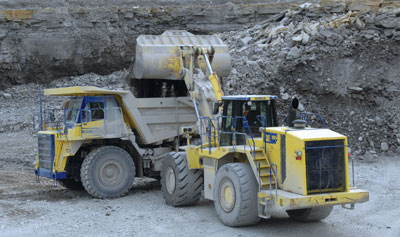 |
|
| Walker Aggregates custom paints its equipment, including this Caterpillar 988 loader and Komatsu 70-ton haul truck at the company’s Severn Pines, Ont., quarry. |
The project, which was completed this past summer, was a four-year process from conception to completion. “We went from a one-million-tonne annual licence to a three-million-tonne annual licence,” explains Steve Bisson, general manager for Walker Aggregates Inc. “Although we had plans in place for the project early on, it wasn’t until 2009 that we actually received the approval for the licence upgrade and started things moving.”
McGillvray, who has been with Walker Aggregates and its predecessors for 36 years and started out as a haul truck operator in a quarry, says for the upgrade project to be viable, they had to find a way to incorporate as much of the existing equipment as possible with new equipment. For Joe Elmes, who has been around the quarry business for years and is now the president of Masaba Canada, that was music to his ears. He had been asked to help Walker Aggregates make the project happen in a cost-effective way, and according to Bisson, Elmes was a key player in the upgrade. “For us, it was very important to have outside consulting on the project, and Joe brought that to the table and became part of the design team,” Bisson adds.
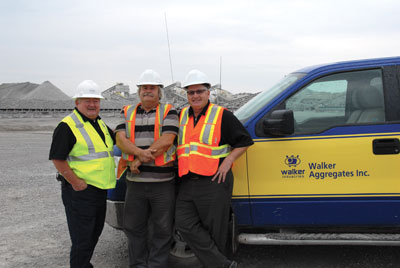 |
|
| The project team included (left to right) Joe Elmes, Roger McGillvray and Steve Bisson.
|
A key component in the project was the acquisition and installation of a primary crusher, which is a used Telsmith Iron Giant 5060 that Walker Aggregates acquired from a quarry in Atlanta, GA. Walker team members spent nine days during the summer of 2010 supervising the dismantling of the crusher and a second visit to Atlanta was required to supervise the loading of the crusher components on to 22 semi trucks for the trip to Severn Pines, which is about a 90-minute drive north of Toronto. In October 2010 the concrete work for the crusher foundation was completed by Chalmers Concrete in nearby Barrie, Ont., and then the crusher was reassembled.
“It was a challenge for us to find a company that could handle the concrete work in our time frame,” adds Bisson. For some companies, the magnitude of the project was just too much. That was unexpected, but we needed someone who could get the work done on time, on budget, and to our specifications, and Chalmers was able to do that for us.”
Production Flow
With the crusher in place, the other new components could be installed and the existing components upgraded as necessary. Today, the production flow at the quarry starts with rock extraction. An outsourced drill provides 4.5 in. holes used in the drilling pattern for the explosives. Following controlled blasting, three haul trucks – two Komatsu 70-ton models and one CAT 70-ton model are loaded with blasted rock by a pair of Caterpillar 988 loaders – one H and one F model. The blasted rock is moved a short distance to a 120-tonne Rock Box to a Diester feeder, which is positioned just before the Telsmith primary crusher. The crusher operator has access to a custom cantilever-mounted BTI BX830 breaker, which is used to break the oversized rock from the blast.
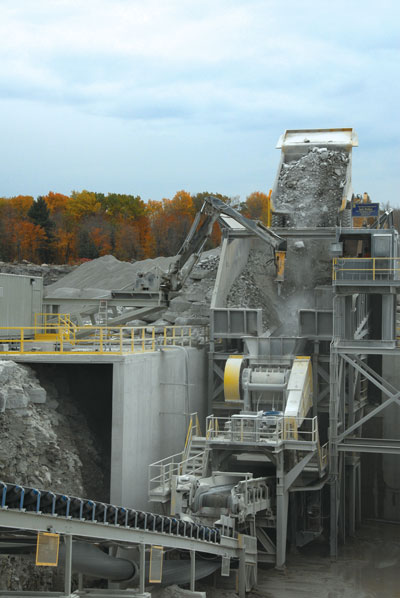 |
|
| As part of its recent upgrade, the Severn Pines quarry installed a Telsmith Iron Giant 5060 primary crusher. The crusher operator also has access to a custom cantilever-mounted BTI BX830 breaker (seen in photo), which can be used to break the oversized rock from the blast.
|
The product generated by the primary crusher is 8 in. minus. It is sent to a surge pile via a 54 in. x 150 ft. Masaba radial stacker. The system utilizes a Masaba reclaim tunnel with three Masaba vibrating feeders and a 54 in. x 500 ft. reclaim belt that is equipped with a Brunone belt flipper to minimize spillage and Brunone spargamats in impact areas. There are two additional belt flippers on site – one on the 54 in. x 230 ft. conveyor after the primary belt and one on the 3/4 in. crushed belt.
A Masaba surge hopper is next in line followed by two Masaba feeders to divide the secondary and tertiary plants. Each side is capable of running 60% of the total load. This plant is designed to run with one or both sides of the secondary and tertiary stages of processing to optimize production time. From there, product goes to two existing ElJay 6 ft. x 20 ft. horizontal screens that direct feed to a pair of Metso 1520 horizontal shaft impactors supported with Masaba structures. McGillvray notes the direct feed to the impactors is unique to this operation. From the impactors, an under crusher conveyor feeds a pair of Metso TS (triple slope) 8 ft. x 27 ft. screens, which are the first two of their kind in the Ontario aggregates business.
All oversize then circulates back to a pair of vertical shaft impactors – a new Actech V750 and a Canica 125 that was on the site prior to the upgrade. From there, the product goes to an existing 8 ft. x 20 ft. triple deck Simplicity screen, or a 7 ft. x 20 ft. JCI horizontal screen. The final products discharge through a set of chutes and blend gates while a Walair separator that was originally designed for the recycling industry removes any contamination (wood, blasting cable, etc.). All of the new conveyors on site were designed and supplied by Masaba.
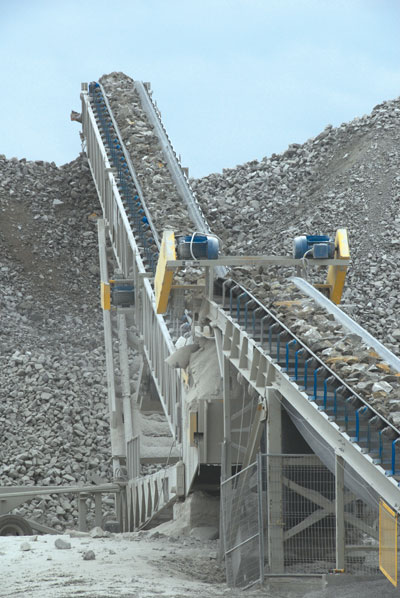 |
|
| Product from the crusher is sent to the surge pile via a 54 in. x 150 ft. Masaba radial stacker.
|
Customers’ trucks are loaded with three shipping loaders – one Caterpillar, one John Deere, and one Volvo, all equipped with noise minimizing backup alarms, as is all Walker mobile equipment on site. The stockpile configuration has also been designed to minimize the need for haulers to back into piles for loading, improving safety and minimizing backup alarms. In addition, the site has a new Canadian scale and a new scale house that is equipped with a lighting system and cameras. An existing Canadian scale is being refurbished and a third scale will be added at a later date, giving the site maximum flexibility during busy times.
Ken Lucyshyn, Walker Industries vice-president of aggregates and construction, was extremely pleased with the project outcome. “Our strategic plan revolves around the growth of our core businesses through current operations, acquisitions or greenfield applications,” he says. “This project had to meet our core values of health and safety and environmental performance, and needed to minimize the impact on our neighbours. I am extremely proud of the team that handled this project; we managed to be on budget, on time and maintained our outstanding health and safety record.”
GM Bisson was also pleased with the outcome. “You could say the ‘perfect storm’ in the economy was good for us when it came time to do the upgrade,” he says. “We were able to secure very competitive quotes on the equipment we needed and we could work with reduced lead times. The strength of the Canadian dollar also helped us out. When you put it all together, we estimate that we saved upwards of 20% on our budget due to the timing of this project.”
Bisson was encouraged by the automation features included in the project. “It was critical for us to implement more automation in the production flow at Severn Pines,” he adds. “It was also important for us to include multiple Belt Way belt scales throughout the process to accurately understand our production capabilities and yields. Combined with RS-36 samplers from InterSystems, we are now better able to understand changes or possible improvements to our production. The smart PLCs allow us to remotely troubleshoot our process, while providing current real-time production information.”
Both Bisson and McGillvray say Wayne Spears Electric played a key role in the project, noting that the Collingwood, Ont., company handled all of the electrical and automation installations, including the PLC work.
Planning and Markets
The Severn Pines crew planned most of the upgrade work for the winter months, when market conditions are typically slower, but Bisson says they also stockpiled inventory so that they could continue to meet customer demand while the operation was shut down for the major part of the upgrade. Having inventory available during the upgrade was imperative to the operation as it processes limestone to supply the local asphalt, concrete and road construction industry. Limestone products from the quarry range from large armour stone (five-plus tonnes) to Limestone fines.
The Severn Pines Quarry is one of nine quarries operated by Walker Aggregates Inc. of Niagara Falls, Ont. Production at Severn Pines started in 1999, but many of the other Walker sites are much older, including the initial Walker operation on the Niagara Escarpment in southern Ontario, which was started by the Walker brothers in 1887. That quarry is still operational today, and is the home of Walker Industries’ corporate offices.
Print this page